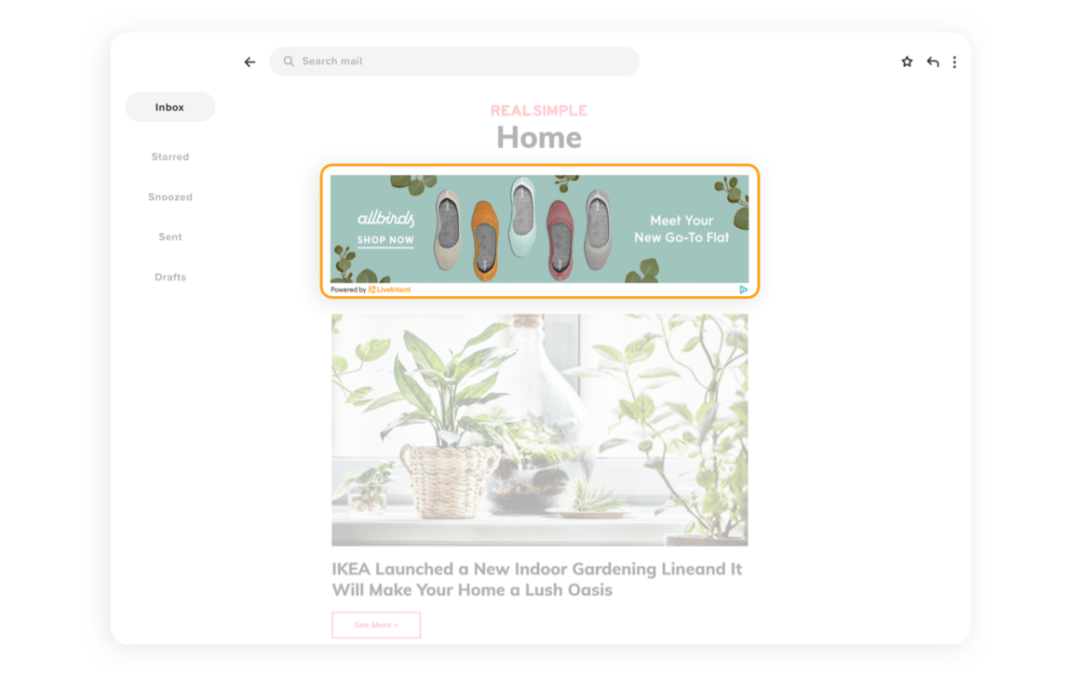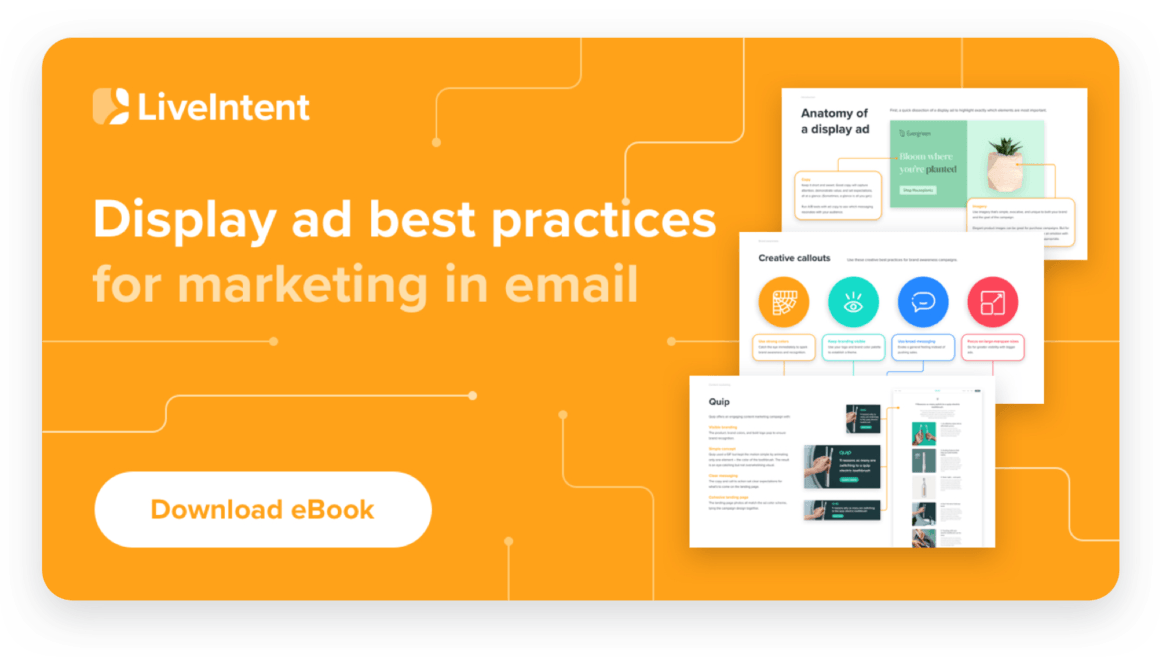Email and email newsletters have long been a preferred channel by brands for driving one-to-one connections with customers. However, email newsletters are more than just a content distribution channel—they’re also a powerful advertising channel. With email newsletters, brands can forge relationships with new customers via premium advertising experiences that deliver added value throughout the customer journey.
Here you’ll get a comprehensive breakdown of advertising in email newsletters. You’ll learn:
- What email advertising is (and what it isn’t)
- Why email is a critical channel to your marketing and advertising mix
- Best practices for advertising in email newsletters
Ready? Let’s get started.
A brief history of email
The first email was sent in 1971 by computer engineer Ray Tomlinson. A few years later, a marketing manager named Gary Thuerk sent the first commercial email. His 400-person email list generated more than $13 million in product sales for his company, Digital Equipment Corp.
Now, email has evolved since the ’70s, and so have content consumption habits. The rise of mobile devices, gave way to faster, more seamless communication. Remember Blackberrys? These devices were pivotal in enabling quick exchanges via email, fundamentally altering the way people did business. These days, Americans spend up to three hours every day in their work inboxes and another two hours checking personal email on average. And as mobile devices have become more sophisticated, so have the ways in which brands connect with their audiences. People now reach for their email inbox instead of the morning paper to the access all the information they need (and consented to receiving). Furthermore, more than 60 percent of consumers cite email as their preferred method of hearing from brands.
It’s safe to say that email is here to stay and has only further solidified its place in consumers’ lives.
What is email advertising?
Although the terms “email advertising” and “email marketing” are sometimes used interchangeably, they refer to very different things.
Email marketing is the use of your proprietary email messaging to reach existing contacts. If you’ve ever sent an email to customers or prospects in your CRM database, you’ve used email marketing as a tactic.
Email advertising, on the other hand, is a subset of paid advertising that allows brands to reach targeted audiences in addition to or outside of their existing CRM database.
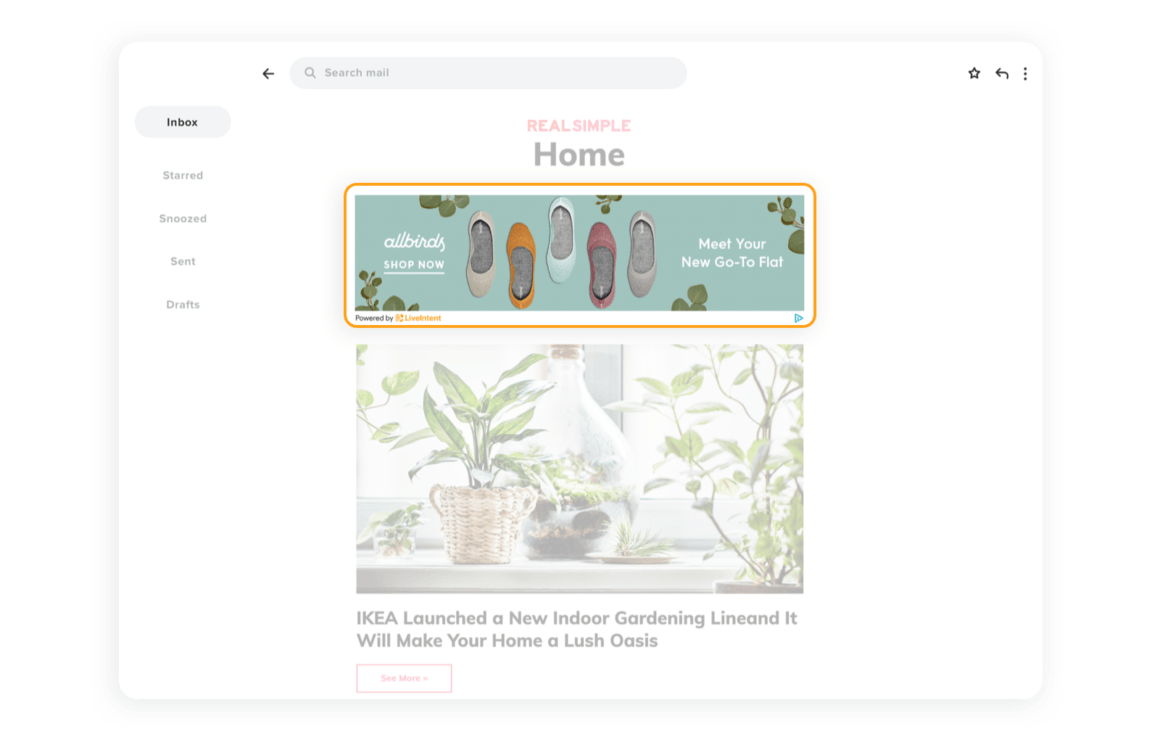
With email newsletter advertising, advertisers can access premium ad inventory in reputable publisher newsletters, like those of The New York Times, and target new and existing audiences in high-trust, high-attention environments.
The unique benefits to advertising in email newsletters
Email newsletters present benefits and advantages that most other channels don’t have. Let’s take a closer look.
Real, logged-in audiences
To access email newsletters, subscribers must log in to their email accounts. There is no need to worry about bots or ad fraud in email newsletters; advertisers can rest assured that they only reach real, logged-in people within the premium environment of email newsletters.

Engaged Subscribers
You know how you tend to pay more attention to the conversations you enjoy having? Email newsletters are the same way.
Because subscribers have opted into the emails they receive, they’re more receptive to, and more likely to engage with email newsletter ads than interruptive pop-ups or banner ads (16 times more likely, to be precise).
Highly visible inventory
Email newsletters are less crowded and noisy than other advertising channels, allowing your email ads to really stand out. Furthermore, email ads located above the fold and at the top of an email newsletter are even more visible still. If you’d like to go beyond the visibility and engagement of display ads in email newsletters, consider native ads instead, but more on that later.
Privacy-safe advertising
Email newsletters do not leverage third-party cookies to enable targeting but rather hashed emails. A hashed email is an email address that’s run through a hashing algorithm returning a series of characters unique to that specific email. Each time an email address runs through a hashing algorithm, the algorithm returns the same unique value. Hashed emails cannot be reversed to reveal a user’s actual email.
The email hash provides advertisers with a privacy-safe method for targeting audiences in email newsletters. With email newsletters, consumers must consent to the use of their email address, adding a layer of privacy. And unlike many other channels, email newsletters are cookieless. This means that newsletter advertisers are unaffected by the third-party cookie’s deprecation.
Expands your first-party data footprint
With third-party cookies on their way out, first-party data will be critical to advertiser survival in a cookieless world. Because email newsletters leverage the email address—a type of first-party data—advertisers can lean on this channel to grow their first-party data footprint.
Depending on the partner you select for your email newsletter advertising, you can access a wealth of audience engagement data. Unlike the walled gardens of Facebook and Google, LiveIntent provides email newsletter advertisers with log-level data that speaks to cross-device engagement, campaign engagement, customer lifetime value (LTV), and log-level exposure data. These are key insights that can be leveraged for retargeting and audience expansion, too.
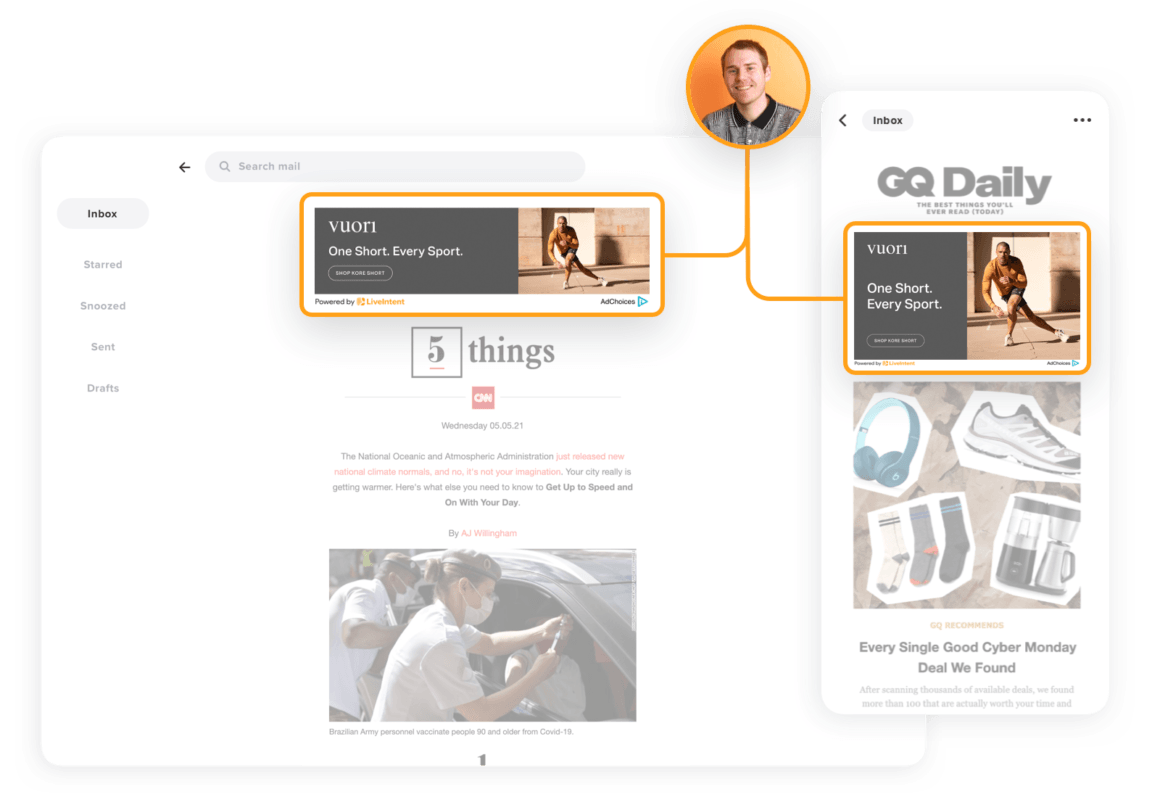
Deterministic ID
Deterministic IDs are clutch when it comes to creating audiences and developing targeting strategies. Here’s why:
People don’t typically share email addresses. So any activity and data tied to an email address, like email newsletter subscriptions, purchases, and the like, is (very likely) representative of the individual consumer habits of that email address user. In other words, brands can create rich, accurate consumer profiles, even in cross-device environments, with a much higher degree of certainty than in often-shared browser environments.
How to buy email newsletter ad inventory
Now that you know what makes email newsletters a powerful advertising channel, you’re probably eager to get started. But before you launch any campaigns, you must first select your inventory.

You can buy email newsletter advertising inventory through programmatic direct-buys, private marketplaces (PMPs), or on the open exchange. Understanding the benefits and advantages of each supply source can help you identify which approach is best for your company, campaign goals, and budget.
Let’s dive in!
Programmatic direct buy
In the case of programmatic direct buys, one can purchase email newsletter inventory directly from a specific publisher; this is a one-to-one relationship between an advertiser and a publisher. Through this arrangement, you can buy inventory as part of either a guaranteed or non-guaranteed deal.
Guaranteed deal: the publisher guarantees the advertiser a certain number of impressions over a set period for a flat, predetermined fee.
Non-guaranteed deal: an arrangement without a specific timeline or set budget for a particular impression goal. These offer more flexibility, letting advertisers reach an impression goal without the commitment of a predetermined fee.
Programmatic direct buys typically consist of a publisher’s most exclusive newsletter inventory. Though it usually comes at a premium fee (higher CPMs), advertisers might feel more comfortable working directly with a publisher. Brands concerned with brand safety or brand suitability, for instance, may want to consider programmatic direct buys to ensure greater control over where their advertisements appear.
Deal IDs are the key component to facilitating programmatic direct buys. A publisher or supply-side platform (SSP) puts together a deal ID specific to the individual campaign. Then the demand-side platform (DSP) sets up the deal ID on their side, aligning both platform sides on terms.
Private marketplaces (PMP)
Private marketplaces are another method brands employ to purchase email advertising inventory. Similar to a programmatic direct buy, this method involves a direct relationship with a single publisher. Rather than a one-to-one buy between an advertiser and publisher, this is a one-to-many approach to email newsletter advertising.
Essentially, a PMP allows many advertisers to compete for the same, fixed amount of inventory from a single publisher within a private environment. Publishers must add advertisers to their allow list to enable their DSP to purchase advertising inventory listed in private marketplaces.
Compared to a programmatic direct buy, a PMP enables advertisers to secure premium inventory quickly and at a lower cost. Private marketplaces provide always-on access to inventory (assuming your brand has permission), making it a turn-key option for advertisers who know the type of newsletters in which they’d like to appear.
Open exchange
Another source for email newsletter ad inventory is the open exchange. Unlike private marketplaces and programmatic direct buys, an open exchange is a public auction. There’s no barrier to entry for advertisers, and there doesn’t need to be an existing contract with the publisher. Inventory is always available for advertisers, and they can bid on whatever they’d like. If you’re a brand looking to achieve reach quickly, the open exchange may be the perfect solution.
Because the open exchange offers more extensive inventory than other types of media buying, advertisers don’t have to sacrifice campaign scale when applying audience targeting, frequency capping, or geo-targeting parameters. However, when compared to programmatic direct deals and private marketplaces, open exchange CPMs are generally lower.
If you’re concerned about brand safety on the open exchange, consider implementing allow lists, block lists, or contextual keyword targeting.
Open exchanges are an accessible, affordable choice that makes sense for many email advertisers – especially brands just getting their programmatic sea legs.
Types of email newsletter ads
You’ve likely encountered email ads in email newsletters, although you might not have noticed they were ads as they plug in nicely into the email’s environment. Or, you might have been so intrigued by one that you immediately did a web search for “Everything I need to know about email advertising” and landed here. If so, welcome! Either way, we’re glad you’re here.
Now, there are two different types of email newsletter ads: custom display ads and native ads.
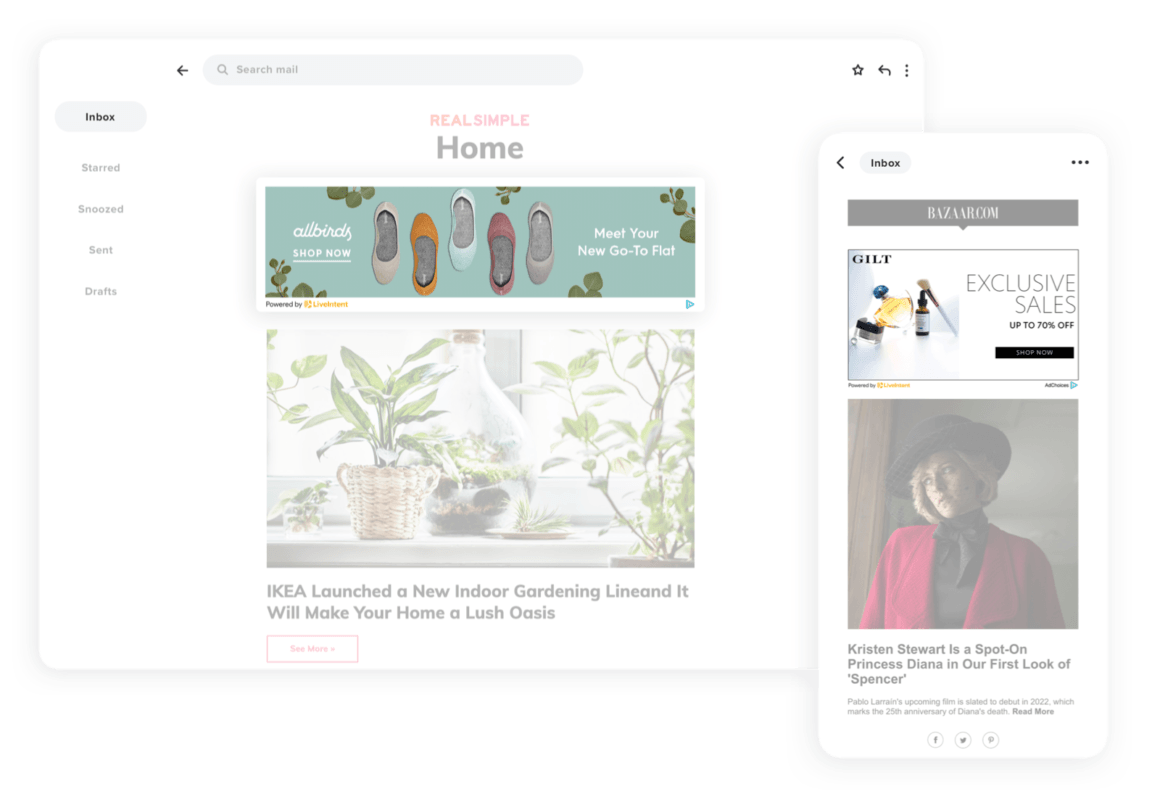
Custom display ads
Custom display ads in email newsletters are similar to web display ads. You can choose from various sizes (970×550, 970×250, 728×90, 300×250) to suit your needs. You can even animate them to capture reader attention and drive engagement. Think GIFs on a mission.
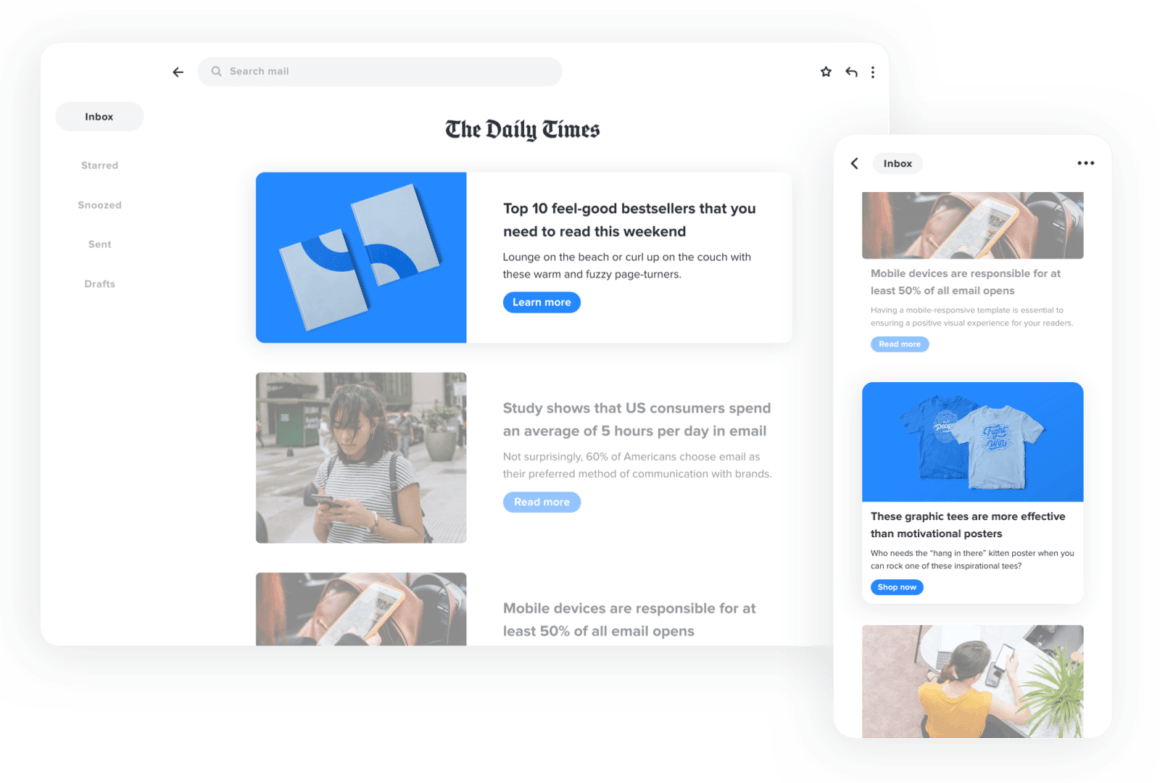
Native ads
Native ads are ad formats that reflect their email newsletter environment and are less intrusive than other forms of advertising. Because native ads integrate more seamlessly into email newsletters content than display ads, newsletter readers don’t experience banner blindness and the ads tend to garner higher engagement rates than display ads.
If you’re interested in leveraging native ads to drive engagement, talk to your account team about purchasing native advertising placements in their email newsletters.
Best practices for advertising in email newsletters
Like any advertising channel, knowing how to maximize your investment to ensure the greatest return is essential to your campaign success. Below we explore key tactics for driving campaign success.
Design scroll-stopping creative
You want to ensure your creative captures the attention of email newsletter readers. To avoid getting skipped over, follow these three design tips for eye-catching creative.
Less is always more. Keep your design and copy minimal, making sure only the most critical information is featured front-and-center. Your tagline or header with a CTA is almost always enough. If you can’t pique your target customer’s attention in fifteen words, you certainly won’t with fifty.
Images are awesome. As the saying goes, a picture is worth a thousand words. Showcase your product either on its own or within a lifestyle context. For instance, an animated ad can showcase different colors or sizes of your products, driving customer intrigue.
Make sure your logo is visible and clear. Make sure existing and prospective customers know whose ad they’re seeing. Your logo builds brand recognition and is an integral part of building connections with customers.
Check out our blog post for more tips on designing effective display ads, or download our Display Ad Best Practices eBook for more in-depth information.
Leverage your first-party data
The name of the game is first-party data. As we mentioned before, first-party data is critical to advertiser survival in the post-cookie era. Lean on your customer relationship management (CRM) data to uncover valuable audience insights that can help you launch impactful advertising campaigns.
Target first-party audiences
Suppose you’re launching a campaign for a new sneaker line. You might look to your CRM database to identify audiences who have purchased your new sneaker line in-store. You can then use this seed audience to build lookalike audiences in a DSP, like LiveIntent’s, to target a broader, similar audience in email newsletters. By leveraging your CRM data, you increase the likelihood that your email advertising campaign will reach and engage the right audience.
Suppress audiences with your CRM data
You might be thinking, “Why would I want to suppress my CRM data?” Well, suppressing your CRM data can help you expand your reach and acquire new customers by targeting audiences outside of your existing CRM database.
Imagine you are running a customer acquisition campaign for your pet food brand. Targeting existing customers wouldn’t be an effective use of resources. However, ensuring that your campaign targets and reaches those who are not your existing customers would be an effective approach to your targeting strategy. This is where suppression comes in. With LiveIntent’s Audience Manager, you can either use Custom or Dynamic Audiences to suppress customers.
Custom Audiences: Suppress existing customers from your campaign entirely by uploading a list of hashed email addresses from your CRM
Dynamic Audiences: Suppress audiences after the conversion. This means you’re not continuing to pay to show ads to new customers who’ve already acted on your CTA
Align key performance indicators to campaign objectives
Aligning key performance indicators (KPIs) to your campaign objectives is critical to measuring and optimizing campaign success. If you’re tracking the wrong metrics, it will be challenging to know if you’re making progress against your goals. For example, if your campaign objective is focused on generating purchases, make sure your KPIs are measuring low-funnel KPIs such as CPA and revenue.
Keep your goals top of mind when creating your campaign KPIs. With the right metrics, you can unlock information that will help inform future advertising strategies.
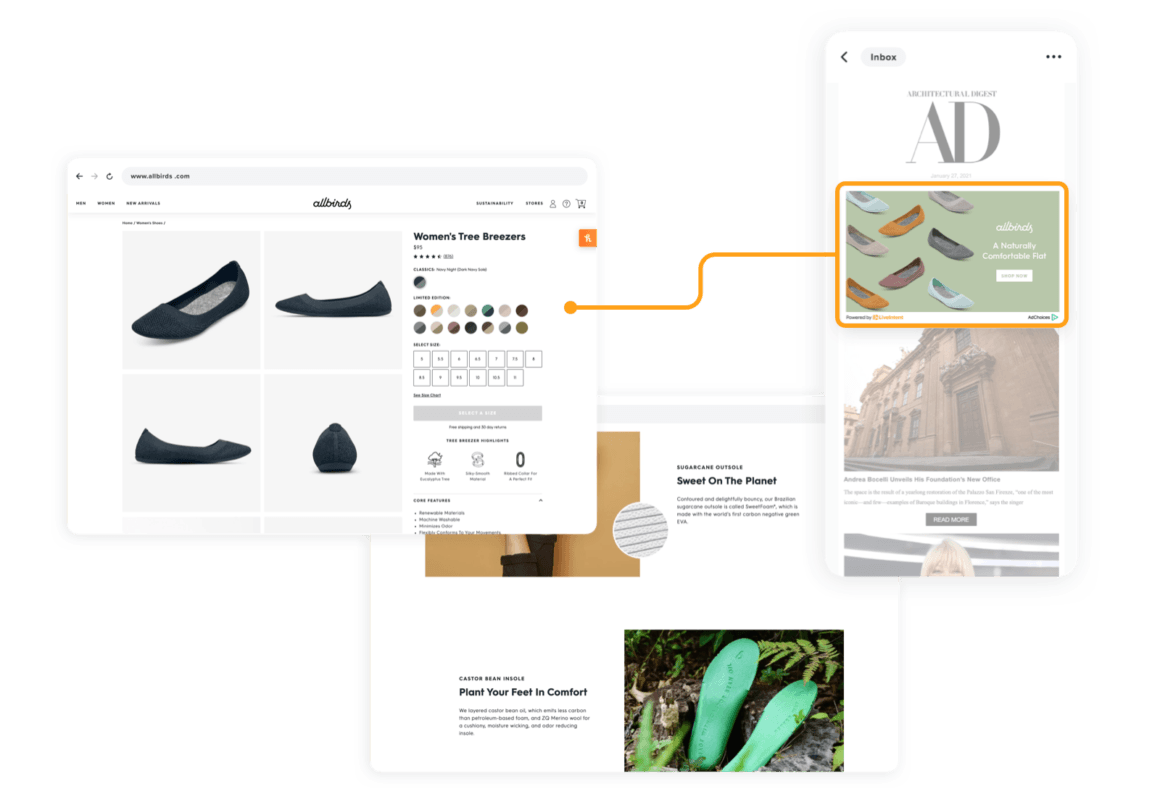
Build killer landing pages
Do not underestimate the power of a great landing page. But what makes a landing page great, exactly? Well, one that drives conversions, of course! Here’s what we mean.
It’s not enough to have stellar ad creative with perfectly crafted CTAs and beautiful imagery. Advertisers must remember that the customer experience continues well after a user clicks on an ad. So, one must also carefully consider the landing page experience. From memorable CTAs to landing page URLs, each element of a landing page is critical to the success of your campaign. When designing your landing pages, a good rule of thumb is to provide your landing page visitor with all the necessary information that will help them complete the intended outcome.
Our VP of Marketing, Nick Dujnic, shared his protips for driving conversions during AdWeek. Check out the blog post with his recommendations for driving conversions with email advertising.
Start advertising in email newsletters
And there you have it. That’s the quick and dirty rundown on everything you need to know about email advertising, from buying inventory to maximizing ROI. Email advertising is one of the best ways to expand your brand’s reach while maintaining a high degree of control over your exposure, your perfect audience, your brand’s message environment, and your campaign goals.
Have more questions? Awesome – because we’ve got answers. Connect with a LiveIntent expert today to learn more about email advertising.

The post Everything You Need to Know About Advertising in Email Newsletters appeared first on LiveIntent Blog.

